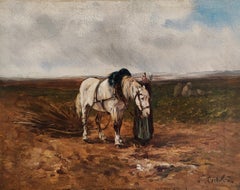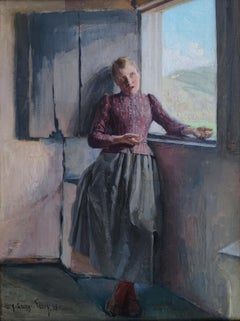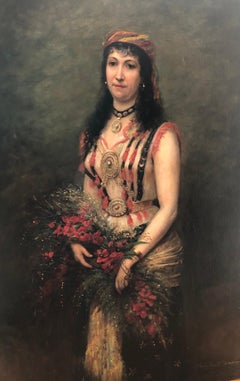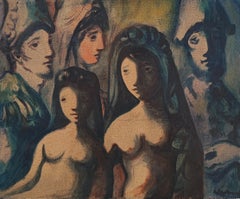Want more images or videos?
Request additional images or videos from the seller
1 of 15
Bricard François XavierThe little smoker
$1,119.89List Price
About the Item
- Creator:Bricard François Xavier (1881 - 1935, French)
- Dimensions:Height: 26.97 in (68.5 cm)Width: 21.86 in (55.5 cm)Depth: 0.79 in (2 cm)
- Medium:
- Movement & Style:
- Period:
- Condition:Original frame.
- Gallery Location:Genève, CH
- Reference Number:1stDibs: LU2018211725992
About the Seller
5.0
Vetted Professional Seller
Every seller passes strict standards for authenticity and reliability
1stDibs seller since 2022
151 sales on 1stDibs
Typical response time: Several days
Authenticity Guarantee
In the unlikely event there’s an issue with an item’s authenticity, contact us within 1 year for a full refund. DetailsMoney-Back Guarantee
If your item is not as described, is damaged in transit, or does not arrive, contact us within 7 days for a full refund. Details24-Hour Cancellation
You have a 24-hour grace period in which to reconsider your purchase, with no questions asked.Vetted Professional Sellers
Our world-class sellers must adhere to strict standards for service and quality, maintaining the integrity of our listings.Price-Match Guarantee
If you find that a seller listed the same item for a lower price elsewhere, we’ll match it.Trusted Global Delivery
Our best-in-class carrier network provides specialized shipping options worldwide, including custom delivery.You May Also Like
Vibrant Mid-Century Church Ceremony Scene with Procession
Located in Cirencester, Gloucestershire
Church Ceremony Scene
Henri Therme
signed oil on board, unframed
board: 13 x 9.5 inches
provenance: private collection
condition: very good and sound condition
Description: This viv...
Category
Mid-19th Century French School Figurative Paintings
Materials
Oil
Fine Antique French Signed Oil Painting Portrait Young Lady in Turban
Located in Cirencester, Gloucestershire
Portrait of a Young Lady wearing pink and a Turban headpiece
by Henri-Charles Daudin (1864-1917, French)
signed oil on wood panel, unframed
board: 14 x 10.5 inches
provenance: privat...
Category
Late 19th Century French School Portrait Paintings
Materials
Oil
19th Century White Chateau Riverside Estate with Boaters Signed French Oil
Located in Cirencester, Gloucestershire
Riverside Chateau
Signed by artist, French circa 1855
Oil painting on canvas, unframed
Canvas: 10.5 x 16 inches
Condition: The painting is in very good condition, with well-preserve...
Category
Mid-19th Century French School Landscape Paintings
Materials
Oil
Orientalist North African Figures Market Stall City Scene large Oil Painting
Located in Cirencester, Gloucestershire
Market Stall Conversation
French School, 20th century
oil on canvas, unframed
canvas : 24 x 20 inches
provenance: private collection, France
condition: sound condition but with consi...
Category
Mid-20th Century French School Figurative Paintings
Materials
Oil, Canvas
Large 1800's French Oil on Wood Panel Portrait of a Rugged Dressed Man
Located in Cirencester, Gloucestershire
Portrait of a Man
French artist, circa 1800's period
oil on wood panel, unframed
panel: 23 x 18 inches
provenance: private collection, Honfleur, Normandy, France
condition: some sur...
Category
Early 19th Century French School Portrait Paintings
Materials
Oil
$1,309
H 23 in W 18 in
St Tropez Harbour Fishermen Tending Nets & Catch Signed Mid 20th Century Oil
Located in Cirencester, Gloucestershire
St. Tropez Harbour
French mid 20th century artist
signed oil on canvas framed
framed: 24 x 28 inches
canvas: 20 x 24 inches
provenance: private collection, France
condition: very goo...
Category
Mid-20th Century French School Landscape Paintings
Materials
Oil, Canvas
Antique French Portrait of a Lady Oil on Panel, Signed & Dated 1915
Located in Cirencester, Gloucestershire
Portrait of a Lady
French artist, signed and dated 1915
oil on panel
board: 13.75 x 10.5 inches
provenance: private collection, France
condition: scuffing to the edges from a previou...
Category
1910s French School Portrait Paintings
Materials
Oil
$1,378
H 13.75 in W 10.5 in
North African Traveller with Camel in Landscape Large Orientalist Oil Painting
Located in Cirencester, Gloucestershire
Traveller in Landscape
French School style, late 20th century
oil on canvas, unframed
canvas : 36 x 24 inches
provenance: private collection, Cornwall, England
condition: very good a...
Category
Late 20th Century French School Figurative Paintings
Materials
Oil
19th Century French Oil Painting Old Chateau Castles on Lake Side Town
Located in Cirencester, Gloucestershire
The Old Chateau
French School, 19th century
signed with initials
oil painting on canvas, framed
framed: 14 x 18 inches
canvas: 11 x 15 inches
Provenance: private collection, England
...
Category
19th Century French School Landscape Paintings
Materials
Oil
North African French Orientalist Signed Oil Painting Figures on Horseback Swords
Located in Cirencester, Gloucestershire
French Orientalist Schooll
late 20th century
signed oil painting on canvas, framed
framed: 30 x 34 inches
canvas: 20 x 24 inches
Provenance: private collection, Cornwall, England
Con...
Category
20th Century French School Figurative Paintings
Materials
Oil
More From This Seller
View AllWoman in the field preparing a draft horse
By Leon Georges Calves
Located in Genève, GE
Work on canvas
Category
19th Century French School Figurative Paintings
Materials
Oil
Young girl standing at the window
Located in Genève, GE
Work on canvas
Molded frame in plaster and gilded wood
59 x 49.5 x 5 cm
Category
1890s French School Figurative Paintings
Materials
Oil
Young woman in oriental costume and flower bouquet
Located in Genève, GE
Work on canvas
Category
Early 20th Century French School Figurative Paintings
Materials
Oil
Characters
Located in Genève, GE
Work on canvas
Category
Mid-20th Century French School Figurative Paintings
Materials
Oil
$1,902
Study of a young woman at night lighting herself with a candle
Located in Genève, GE
Work on wood
Category
20th Century French School Figurative Paintings
Materials
Oil
Young girl in a pink dress and red headband (verso nude study)
Located in Genève, GE
Work on cardboard
Dimension with frame :60 x 49 x 6 cm
This captivating work, dated 1950, presents a striking portrait of a young girl captured in a moment of intimate contemplation....
Category
1950s Realist Figurative Paintings
Materials
Oil
Recently Viewed
View AllMore Ways To Browse
Russian Palace
Vintage Ballerina Painting
Antique Painting Of Children
Egg Tempera Contemporary Painting
Oil Painting Xix
Very Large Oil Paintings
Young Girl Young Boy Painting
France 1870 Art
Old Dutch Paintings
Opera Painting
Peasant Painting
Wedding Painting
Black Baroque Frame
Boxing Painting
Christ Oil Painting
Girl With Flowers
Paul Louis Bolot
Rod Stewart



